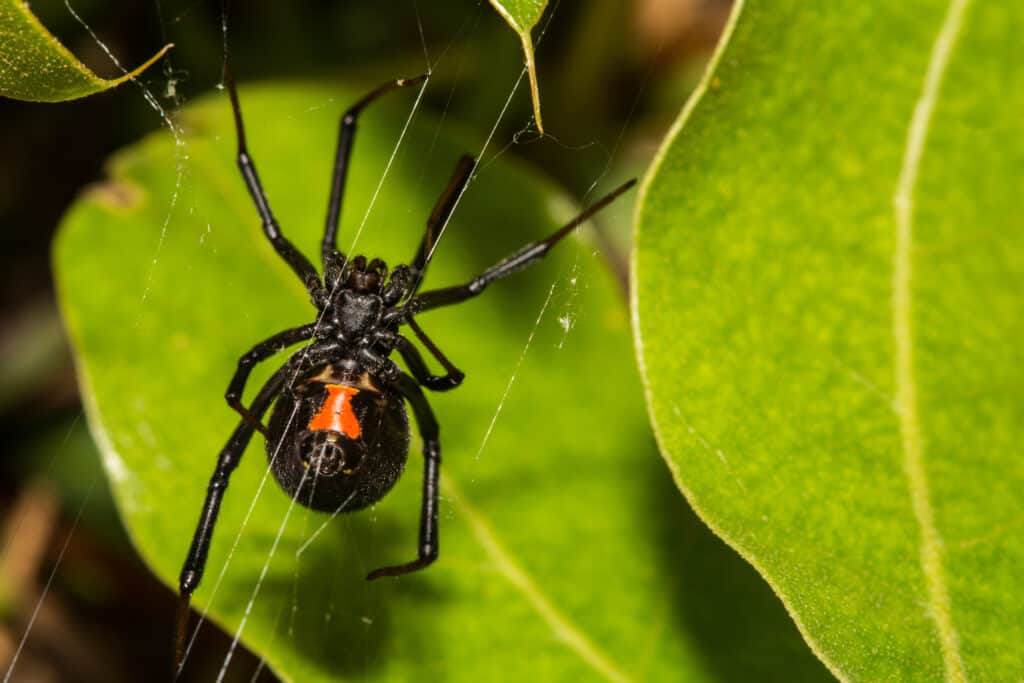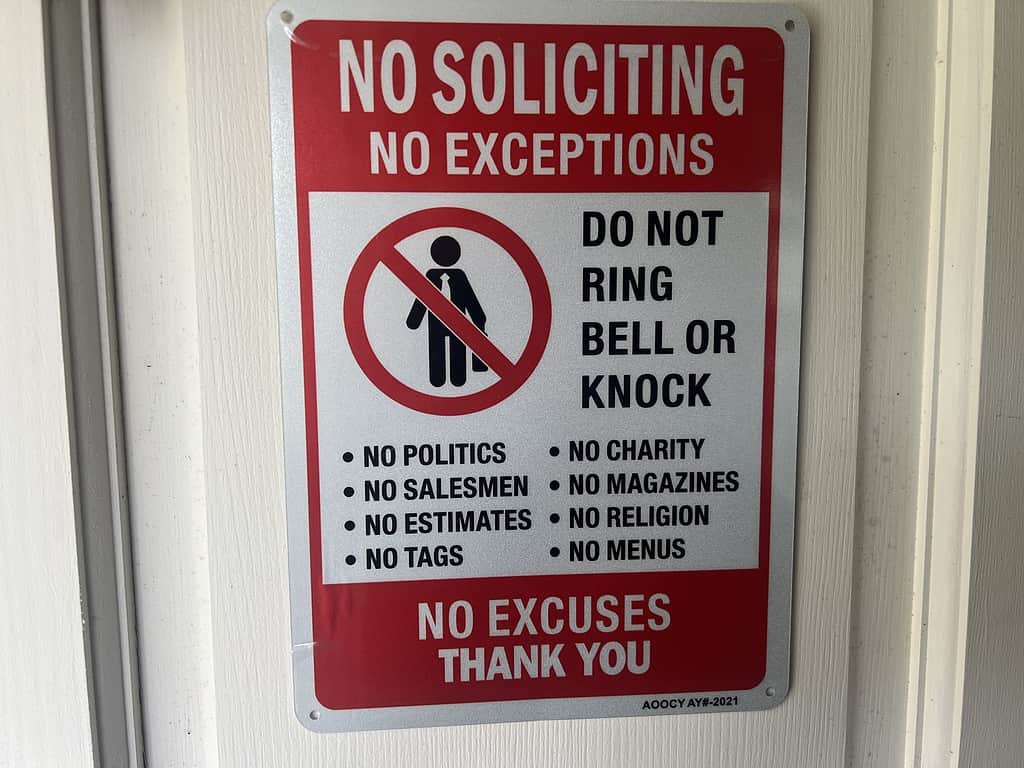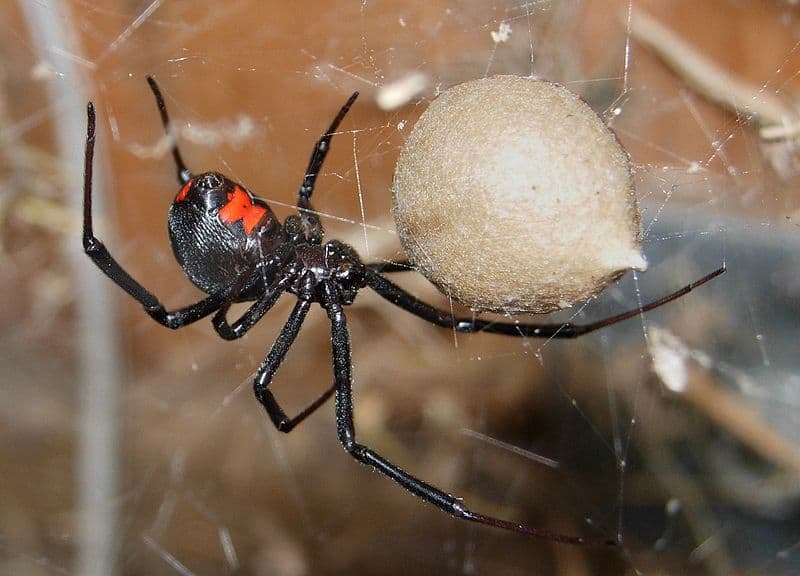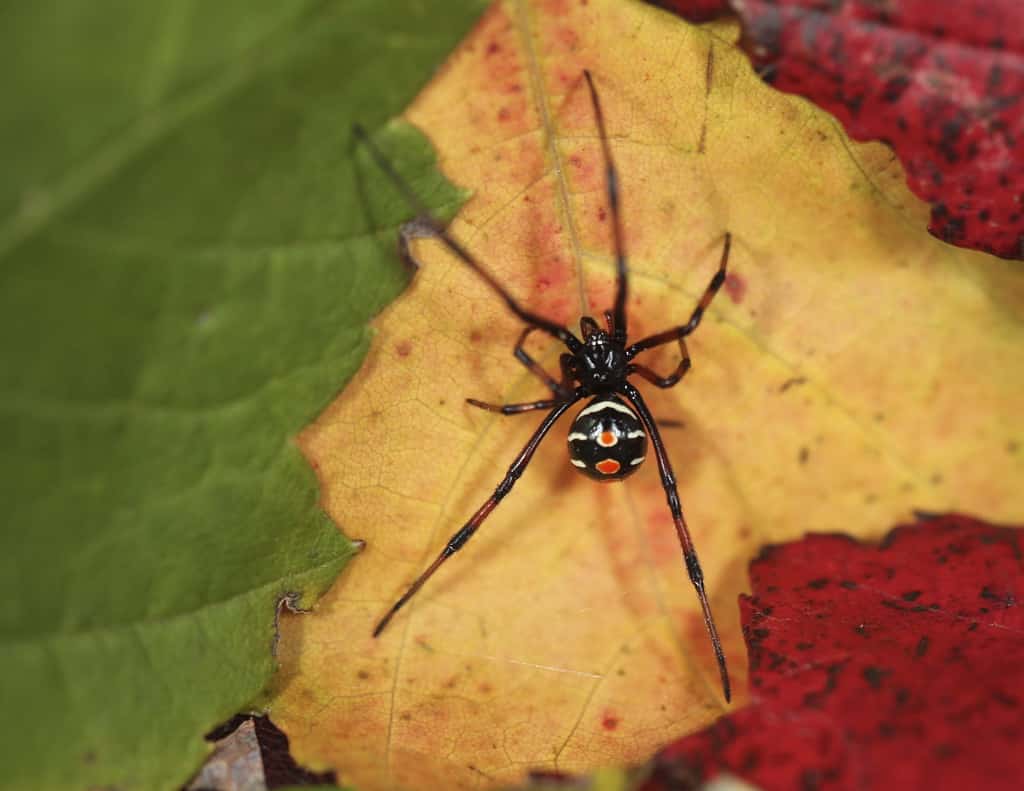Does that little black spider with the menacing red hourglass on their belly give you the heebie-jeebies or, quite frankly, terrify you? You aren’t alone. Millions of people agree that the small delicate black widow is what may fuel nightmares, while others believe the spider makes a great pet. Here at A-Z Animals, we scoured scientific research and checked with a couple of arachnologists on why the creepy crawler sports the red hourglass and have some news to share with you.
What Is a Black Widow?

Black widow spiders induce fear into the hearts of many because of their venom, yet they very rarely bite.
©Jay Ondreicka/Shutterstock.com
The black widow spider is a pea-sized black spider with a legspan of up to 1.5 inches and a red hourglass on the underside of its abdomen. Sometimes the spider may also have red, orange, or yellowish markings on the top of the abdomen. The hourglass may also be these colors instead of strictly red. Sometimes the hourglass may be spots instead or a part of the hourglass. It varies from spider to spider.
The black widow spider creates sloppy webs in very small, hidden from human sight places. They are good at choosing boxes in garages or attics, where you might store seldom-used goods, like holiday decorations. Typically, these spiders only live for a year, so it’s believable that they would never know that some boxes will be opened periodically, which, in this case, will thoroughly disrupt their lives.
Another sneaky but easily mistaken hiding place may be inside hanging gloves, discarded shoes, rainboots, children’s outdoor toy boxes, and other places where “cobwebs” gather. The black widow is one of many spiders that make up the family Theridiidae under the order Araneae. Theridiidae, are also commonly referred to as tangled-web spiders or cobweb spiders. Their webs are very sloppily done and may look like old cobwebs filled with dust. These “cobwebs” are far from abandoned. Timid, introverted, adorable “itsy bitsy spiders” call the mess home.
Bite Consequences
Not all of the spiders in the cobweb family are harmful, but they all have a similar body type and appearance. A very common house spider is a cobweb spider and is closely related to the widow. There are over 3,000 cobweb spider types in the world.
Black widows contain a type of neurotoxin called alpha-latrotoxin. This is one of the strongest venoms in any spider. If you have received a bite from a black widow spider and receive a full dose of venom, you will have many unpleasant side effects. Healthy adults rarely die from the bite, so there is quite a bit of superstition attached. Children, sensitive individuals like those with an allergy to venom, those who have certain diseases, and the elderly can die from a single bite. It is best to seek immediate medical attention just to be on the safe side.
The side effects of the venom can include severe pain at the site with swelling, nausea, muscle pain, mild paralysis of the diaphragm, which makes breathing difficult, headache, and weakness. The pain can be so severe that the victim may think they are having a heart attack or have appendicitis. The venom can also make blood pressure rise to dangerous levels. Over 12 hours, these symptoms may worsen. Antivenom is rarely necessary but is available.
Introverted: Please Do Not Knock

No solicitation sign is what every spider wishes they had.
©A-Z-Animals.com/Katie Downey – Original
Just the same as introverted people, these spiders just really want to remain left alone to catch tiny insects and live out their days. Though it is very uncommon in the wild, black widow females can live up to three years. However, this is not said for the males of the species.
The females are common in the pet trade for their beauty and docile nature. Surprised? Yes, the black widow is a very docile spider. They don’t like feeling threatened, hurt, or grabbed and will do the only thing they can to defend themselves in that instance, which is to bite. Though many times their bite is not packed with killer venom, it can just literally be a bite from a small spider without lasting consequence. However, it is not something anyone wants to experience. The bite from a black widow ranks at number one for the most painful bite from a spider in the world.
Other times, their bite can yield significant results. This normally only occurs with children and sensitive individuals. They can be handled safely when they are not feeling threatened, though it is not advised. When anything in the animal kingdom feels threatened, tragedies can occur. As humans, we also do not take kindly to being threatened. Be sure to give everything found in nature plenty of space and respect.
What About the Hourglass?

This black widow has the typical red hourglass shape and is upside down, as they generally are, to show birds they mean business.
©Chuck Evans(mcevan)”./ CC BY 2.5, via Wikimedia Commons – Original / License
Now that you know a bit about the black widow spider, let’s talk about why they have that evil-looking hourglass on their bellies. It isn’t hard to guess. Most animals that have bright coloring in one way or another are that way to symbolize a big red flag to predators. They are making it loud and clear that it is unwise to eat them because they will be the predator’s last meal. The animals with bright colors are sending a message to everyone that they are poisonous if eaten.
Their markings represent danger so anything choosing to make a meal of them should be cautious and move on to a less harmful meal. If a bird chooses to eat a black widow spider, they are accepting the consequences. The consequence is death or at least that’s what the little spider wants everyone to believe. Most of the time, anything that chooses a black widow as a snack will deal with a very upset stomach and little else. Most animals will remain unbothered by eating it but will remember not to eat another one. That does little to help the eaten one.
Researchers in Durham, North Carolina, at Duke University, found that birds are much more equipped to see the red on a black widow than insects are. Black widows tend to hang upside down so that the hourglass is viewable to birds. The researchers found that birds are three times less likely to peck or make a snack of a black widow with a viewable red hourglass than they are of a spider without a red hourglass.
How to Avoid Getting Bitten By a Black Widow Spider

Black widow spider with dots on its abdomen instead of an hourglass.
©A-Z-Animals.com/Katie Downey
It’s easy to avoid a bite by one of these spiders if you rarely go outside and clean your home thoroughly every week. Not everyone has that ability or wants that lifestyle. Those who work outside, whether it’s gardens or general labor, are at a higher risk. Children with bins filled with dusty toys outside are at risk. Black widow spiders are almost everywhere in the world, whether it’s their cousins, the redback spider, or different types of black widows found in the US.
Gloves and Boots
If left with no other choice than to hang up your wet gardening gloves and leave your dirty boots outdoors, stick a strong-smelling peppermint or lemon balm ball inside each. Spiders are strongly avoidant of strong smells like peppermint. Also, stuff the gloves and boots with newspaper. It will help them dry faster and block entry. Always be sure to bang boots or upside-down shoes against something to knock loose anything that might be inside.
If you have bins of gardening tools or children’s toys outdoors, dump them out frequently and keep a tight lid on them. Throw a couple of lemon balm or peppermint balls inside for extra safety. Always be sure to thoroughly inspect your children’s toys before letting them play. Children are more likely to receive a bite simply because they are not as observant as an adult.
Remove Clutter
Another great way to minimize potential interactions with black widow spiders is to keep your home, both indoors and outdoors, clutter-free. Remember, these spiders just wish for everyone to leave them alone to live their lives in peace. They are excellent at cutting down on nuisance insects and will only bite as a last resort if they are in danger. They do not want to bite you but if it’s either that or death, they do what anyone would do and defend themselves the only way they know how. After all, WE are the big scary creatures that hurt so many flora and fauna, whether we mean to or not.
FAQ

Northern black widow spider (Latrodectus variolus) found in colored fall maple tree leaves.
©iStock.com/NajaShots
Q: Do black widows always have an hourglass on their abdomen?
A: Nope! Sometimes black widows have two small dots with space in between. The hourglass and dots can also vary in color from yellow to orange to red. If it looks like a black widow spider but does not have an hourglass, it is most likely a false widow, a close relative of the black widow.
Q: What is the most deadly spider?
A: The Sydney funnel weaver (Atrax robustus) from Australia is the most deadly spider in the world! The spider is typically seen in humid environments with plenty of moisture like under logs, fallen leaves, and in gardens. With a Sydney funnel weaver spider, if they bite on the torso of a human, that person has approximately 15 minutes to live most of the time. No other spider can inflict such a deadly bite that works that quickly.
Q: What spider bite hurts the most?
A: The black widow spider has, by far, the most painful bite of any spider in the world. Its close cousin, the redback spider, the Australian black widow, is also very painful. Though it may be the most painful, it is not the most harmful. A victim will rarely die from their bite.
Q: How common is it to find a black widow spider in a home?
A: Black and brown widows, also known as false widows, are seldom seen indoors. It may be possible that one may sneak in through a crack under your door or along your window as the temperatures cool. Indoors they generally find a quiet corner to make their messy “cobweb-style” web and keep to themselves. They could use the opportunity to climb into a shoe or in your blankets, which is not what anyone wants to have happen.
The photo featured at the top of this post is © James Gathany / public domain – License / Original
Thank you for reading! Have some feedback for us? Contact the AZ Animals editorial team.







